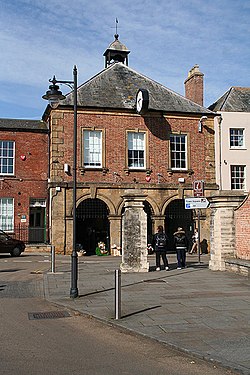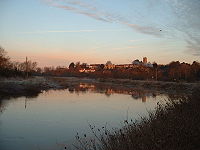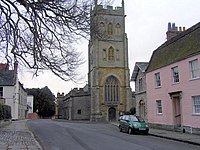Langport
| Langport | |
| Somerset | |
|---|---|
 The Town Hall | |
| Location | |
| Grid reference: | ST420268 |
| Location: | 51°2’15"N, 2°49’39"W |
| Data | |
| Population: | 1,067 (2002 est.) |
| Postcode: | TA10 |
| Dialling code: | 01458 |
| Local Government | |
| Council: | South Somerset |
| Parliamentary constituency: |
Somerton and Frome |
Langport is a town in Somerset, standing 5 miles west of Somerton. The town has a population of 1,067. The parish includes the hamlets of Bowdens and Combe. The town is almost contiguous with Huish Episcopi.
Langport stands on the steep hill tumbling down to the River Parrett and the Somerset Levels and it is best known for the great arch over the main road on the hill, on top of which is the The Hanging Chapel.
The town is split between the old parish of Combe (the area tio the north) within the Kilmersdon Hundred and Langport Eastover in the Hundred of Pitney.
Name of the town
Langport (old forms are "Langeberga", "Langeport") consists of two parts, one on the hill and one by the river. The former owed its origin to its defensible position, and the latter its growth to its facilities for trade on the chief river of Somerset.[1] Its name looks like Old English for "long port" or "long market town", which could refer to the causeway which is now Bow Street. Many of the houses in Bow Street tilt backwards due to settlement of the land behind the causeway.
Langport is divided in two: Langport Eastover is on the east bank of the east bank of the Parrett and Langport Westover on the west bank. The main town is Langport Eastover, which name still describes the part by the river, while Langport Westover across the Parrett is now known locally just as Westover.
Geography

Langport lies on the east bank of the River Parrett, below the point where that river is joined by the River Yeo. There is a causeway across the moor and an important bridge over the river. Below Langport the Parrett is tidal. The rivers flow from the southern hills through Thorney Moor and Kings Moor, through a gap between the upland areas around Somerton and Curry Rivel, onto the Somerset Levels through which it flows past Bridgwater to the Bristol Channel. During the winter the low-lying areas around Langport are sometimes flooded.
Langport Railway Cutting is a Geological Conservation Review site where Gravels are exposed which show scour-and-fill structures consistent with braided stream deposition from the Pleistocene age.[2]
To the south of the town is Wet Moor a biological Site of Special Scientific Interest which is part of the extensive grazing marsh grasslands and ditch systems of the Somerset Levels and Moors.[3] In storm conditions the rivers can surcharge their banks and overspill into the adjacent low lying moorland. The rivers running through the moor make home for many wildlife, including wintering Whooper Swans.[4]
Parish church

The main street leads up a slope from the river to the fine Perpendicular church of All Saints, which is a Grade I listed building. The octagonal tower, which is in three stages, dates from the 15th century but the top section was rebuilt in 1833. It has a number of interesting gargoyles known locally as 'hunky punks'.[5] The East window of the chancel contains a set of late 15th century glass depicting various saints, appropriate to the dedication "All Saints". Although restored in the 19th century it is one of the best preserved mediæval windows in Somerset. Additionally it is unusual in that the window contains a full set of glass from the same period. The church is no longer used for services and is in the care of the Churches Conservation Trust,[6] who have carried out extensive rebuilding work.[7] Its congregation has been merged with nearby St Mary's.
History
Langport is on the ancient way from Glastonbury to Taunton. Its position might have been important during the Roman occupation as there were several villas in the vicinity, but no Roman tiown is known here.
In the Anglo-Saxon period Langport was one of the forts listed in the Burghal Hidage indicating its strategic position to King Alfred, as well as being close to the royal centre of Somerton. In 1086 according to Domesday Book it had 34 resident burgesses and was worth the large sum of £79-10s-7d.
The first charter was given by Queen Elizabeth I in 1562 and recognized that Langport was a borough of great antiquity, which had enjoyed considerable privileges, being governed by a portreeve. It was incorporated by King James I in 1617, but the corporation was abolished in 1883. Langport was represented in parliament in 1304 and 1306. In mediæval times Langport was an important centre for cloth making.[8]
The charter of 1562 granted three annual fairs to Langport, on the 28th of June, the 11th of November and the second Monday in Lent. One fair only is now held, a horse and cattle fair on the 3rd of September. A Saturday market was held under the grant of 1562, but in the 19th century the market day was changed to Tuesday.
On 10 July 1645, the Battle of Langport was fought here, in which the last effective Royalist field army was destroyed and the Parliamentary victory in the Civil War became all but inevitable. When the Royalists retreated through the town many were killed by the bridge over the Parrett, and many of the buildings were set on fire. Although one authority states this was an act by the Parliamentary cavalry, reading contemporary accounts of the battle it is clear that the Royalist cavalry set the lower town on fire in the hope that this would hinder the pursuit led by Cromwell's cavalry.[9]

In 1826 it was the birthplace of Walter Bagehot a businessman, essayist and journalist, who wrote extensively about literature, government, economic affairs and other topics. He went into partnership with George Stuckey and by 1866 the company owned 14 East Indiamen as well as 19 barges on the River Parrett. This developed into the Somerset Trading Company. Stuckey's Bank had been founded in 1770 and by 1909 its banknote circulation was second only to that of the Bank of England. It was then taken over by Parr's Bank which became part of the Westminster Bank.[10]
The Great Bow Bridge, which now carries the A378, is a three-arched bridge, constructed under the terms of the Parrett Navigation Act of 1836. Completed in 1841 at a cost of £3,749,[11] it replaced the previous mediæval bridge, with its nine tiny arches, all too small to allow navigation. A bridge at this site was first mentioned in 1220.[12] The mediæval bridge consisted of a total of 31 arches, of which nine crossed the river, and 19 of the original arches were located by ground-penetrating radar in 1987, buried beneath the road which runs from Great Bow Bridge to Little Bow Bridge.[13]
Around 1840 the Westport Canal was built which joined the river at Langport.[14] The abortive Ivelchester and Langport Navigation scheme had sought to avoid the Great Bow Bridge, by making the Portlake Rhine navigable, rebuilding Little Bow Bridge in the centre of Langport, and making a new cut to Bicknell's Bridge. Seven locks, each with a small rise, were planned but the scheme foundered in 1797, due to financial difficulties.[15] The railway came to Langport in 1853 and opened up new markets, but caused the decline of river traffic.
In 1856 the proprietor of the Langport Herald, James Richard Moreton, printed and published the 107 hymn tunes and 6 anthems written by his father, who was the minister of Langport Independent Chapel. This was the Reverend James Moreton's "Sacred Music", used by Congregationalists and other denominations in the nineteenth century (there is a copy in the British Library).
In Second World War Langport was the site of a United States Army military prison.[16]
Sights of the town

Two buildings in the town, The Tudor house and The Warehouse in Great Bow Yard have been restored by the Somerset Buildings Preservation Trust.[17]
The Hanging Chapel
Close to All Saints Church, an archway crosses the road, bearing a Perpendicular building known as The Hanging Chapel.[18] After serving this purpose it housed first the grammar school (founded 1675), then the Quekett museum, named after John Thomas Quekett (1815–61) the histologist, a native of the town, whose father was master of the school. The hanging chapel afterwards became a masonic hall.
Outside links
| ("Wikimedia Commons" has material about Langport) |
References
- ↑ "History of Langport". Langport.org.uk. http://www.langport.org.uk/history.shtml. Retrieved 10 January 2011.
- ↑ "Langport Railway Cutting SSSI". English Nature. http://www.english-nature.org.uk/citation/citation_photo/1000856.pdf. Retrieved 10 January 2011.
- ↑ "Wet Moor" (PDF). English Nature. http://www.english-nature.org.uk/citation/citation_photo/1004500.pdf. Retrieved 2006-09-09.
- ↑ Wetland management. http://books.google.com/books?id=OQmpDU-wQ40C&pg=PA88&sig=w1RCT_ddXiH2Iqj8wYd6lh47b08#PPA88,M1.
- ↑ "Church of All Saints, Langport". Images of England. http://www.imagesofengland.org.uk/details/default.aspx?pid=2&id=263185. Retrieved 2008-03-05.
- ↑ "Church of All Saints, Langport". The Churches Conservation Trust. http://www.visitchurches.org.uk/content.php?nID=11®ion=Somerset&churchID=161. Retrieved 2008-03-05.
- ↑ "The Churches Conservation Trust". The Institute of Historic Building Conservation. http://www.ihbc.org.uk/context_archive/64/cct/cct.html. Retrieved 2008-03-05.
- ↑ Richardson, Mrianda. "An archaeological assessment of Langport and Frog Lane" (PDF). Somerset County Council. http://www1.somerset.gov.uk/archives/hes/downloads/EUS_LangportText.pdf. Retrieved 10 January 2011.
- ↑ Barratt, John (2005). The civil war in the south west. Bernsley: Pen & Sword Military. pp. 115–127. ISBN 1844151468.
- ↑ "Stuckey's Banking Co Ltd, Taunton, 1826-1909". Royal Bank of Scotland. http://heritagearchives.rbs.com/wiki/Stuckey%27s_Banking_Co_Ltd%2C_Taunton%2C_1826-1909. Retrieved 10 January 2011.
- ↑ Body, Geoffrey; Gallop, Roy (2006). Parrett River Trade. Bristol: Fiducia Press. pp. 16–20. ISBN 978-0946217250.
- ↑ "Great Bow Bridge". Images of England. English Heritage. http://www.imagesofengland.org.uk/Details/Default.aspx?id=263143. Retrieved 22 December 2009.
- ↑ Otter, R. A. (1994). Civil Engineering Heritage: Southern England. London: Thomas Telford. ISBN 0-72771-971-8.
- ↑ Dunning, Robert (1983). A History of Somerset. Chichester: Phillimore & Co. ISBN 0-85033-461-6.
- ↑ Body, Geoffrey; Gallop, Roy (2006). Parrett River Trade. Bristol: Fiducia Press. pp. 13–15. ISBN 978-0946217250.
- ↑ Wakefield, Ken (1994). Operation Bolero: The Americans in Bristol and the West Country 1942-45. Crecy Books. pp. 35. ISBN 0947554513.
- ↑ "The Warehouse Trust Langport". Somerset Rural Renaissance. http://www.somerset-rural-renaissance.co.uk/projects-warehouse-trust-langport.html. Retrieved 14 May 2010.
- ↑ "The Hanging Chapel". Images of England. http://www.imagesofengland.org.uk/details/default.aspx?pid=2&id=263183. Retrieved 2006-11-06.
